Overview of assisted dying applications
Figure One gives an overview of the pathway from initial application to an assisted death. Please note, we have made some changes of the diagram in this quarterly report so that the assisted dying process is clearer, and the data is more functional.
Between 7 November 2021 and 30 September 2022, there were 596 applications made for assisted dying. As of 30 September:
- 294 applications were eligibility confirmed. 216 people1 of the 294 applications had an assisted death, and the remainders are those who:
- withdrew their application; or
- died of their underlying conditions before their scheduled assisted death; or
- we're waiting for their scheduled assisted death at the time the data was extracted.
- 120 applications had been assessed as ineligible for assisted dying
- 68 applications are still in the assessment phase
- 259 applications did not continue the process (due to being ineligible, withdrawing or dying of underlying conditions)
Notes:
1. People who made multiple applications are only counted once for assisted death.
2. Applicants may withdraw their applications or die of their underlying conditions at any stage of their application. Therefore, a sum of the above numbers may be greater than the total number of applications.
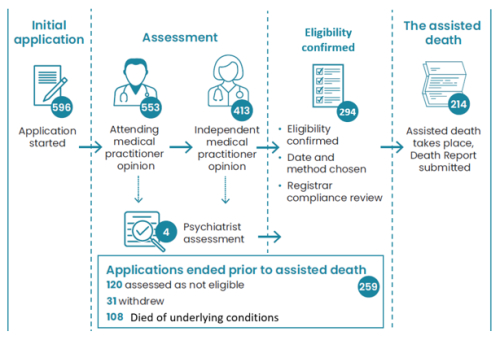

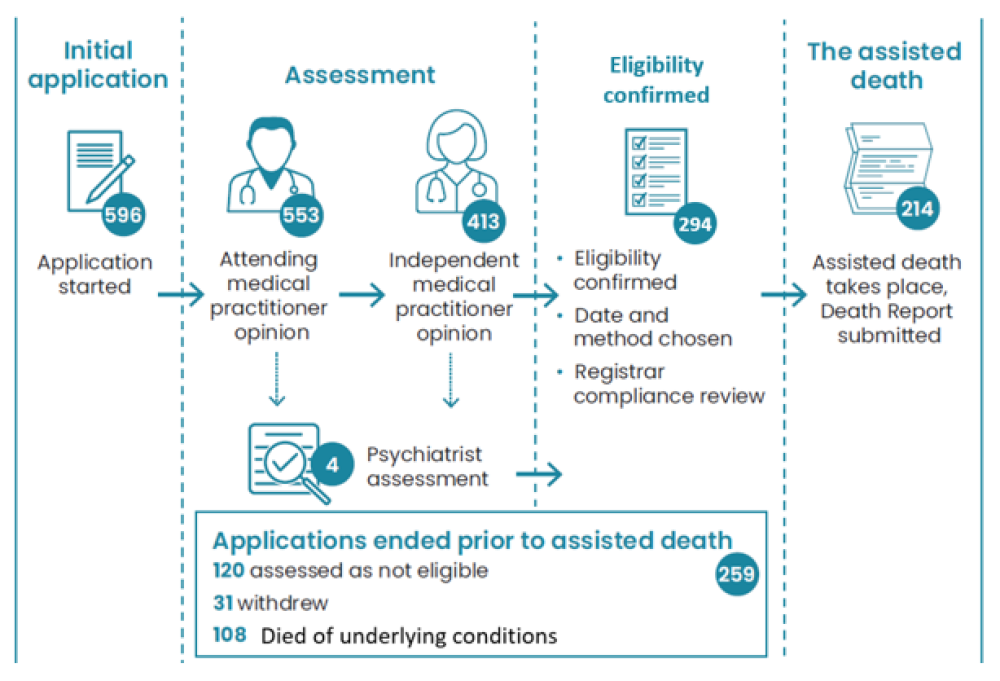
Figure One: Overview of applications received as at 30 June 2022- Text description
Diagram shows an overview of how the applications received up until 30 June 2022 have progressed through the assisted dying service pathway
400 people applied for assisted dying
363 first assessments were completed by attending medical practitioners
270 second, independent, opinions were completed by independent medical practitioners
3 psychiatrist opinions have been completed
101 of the 400 applications are still in process
57 people are still in the assessment phase and 44 have completed assessment and had eligibility confirmed
153 of the 400 applications ended prior to assisted death
68 people were not eligible, 23 withdrew their application and 62 died of natural causes
143 of the 400 people that applied have had an assisted death
Assisted dying applications started by month
Figure Two shows the number of applications started by month, noting that November 2021 was not a full month. An application is defined as started when the first form (the Advice and Request form) is received by the Secretariat. Please be aware, this does not count people who:
- contact the Secretariat with general queries
- died of an underlying condition before making a formal application
- were unable to be contacted
- changed their minds before filling the Advice and Request form
- screened out by the Secretariat before the Advice and Request form



Figure Two: Applications started by month 7 November 2021 – 30 September 2022
Demographics of applicants
Table One shows the demographic breakdown of applicants by ethnic group, gender, age group, diagnosis and whether they are receiving palliative care or not. The assisted dying service is relatively new, and numbers are small. It is expected that the percentage breakdowns will change over time.
As at 30 September:
- 78.8% of applicants are NZ European/Pākehā
- 4.8% of applicants are Māori
- 56.9% are women
- 74.8% are aged 65 years or older
- 65.6% have a cancer diagnosis
- 77.9% were receiving palliative care at the time of application.
Table One: Demographics of people that have applied for assisted dying
| Demographic breakdown | Number of people3 | % of applicants | |
|---|---|---|---|
| Ethnic group1 | Māori | 29 | 4.8 |
| Pacific | 3 | 0.5 | |
| Asian | 11 | 1.8 | |
| NZ European/Pākehā | 476 | 78.8 | |
| Other ethnic groups | 85 | 14.1 | |
| Gender | Female | 339 | 56.9 |
| Male | 257 | 43.1 | |
| Gender diverse | 0 | 0.0 | |
| Age group | 18-44 years | 14 | 2.3 |
| 45-64 years | 136 | 22.8 | |
| 65-84 years | 334 | 56.0 | |
| 85+ years | 112 | 18.8 | |
| Diagnosis category | Cancer | 391 | 65.6 |
| Neurological condition | 56 | 9.4 | |
| Other diagnosis | 54 | 9.1 | |
| Diagnosis not known2 | 95 | 15.9 | |
| Receiving palliative care at time of application? | Yes | 464 | 77.9 |
| No | 128 | 21.5 | |
| Not stated | 4 | 0.7 | |
| Total | 596 | ||
Notes:
1. Total ethnicity has been used. This means that people with more than one ethnicity are counted against each ethnicity they identify with.
2. ‘Diagnosis not known’ includes people that applied but have not yet had their first assessment with their Attending Medical Practitioner as well as those that withdrew, died before this assessment was completed, or were ineligible due to not having a terminal illness.
3. People are counted multiple times if they made application more than once.
Assisted deaths by location
As at 30 September 2022, 216 people had an assisted death. Assisted deaths can take place at the person’s home or in the community. The breakdown by location is:
- 177 (or 81.9%) at the person’s home or another private residence
- 13 (or 5.7%) in aged care facility
- 18 (or 9.1%) in public hospital1
- 8 (or 3.6%) in a hospice facility.
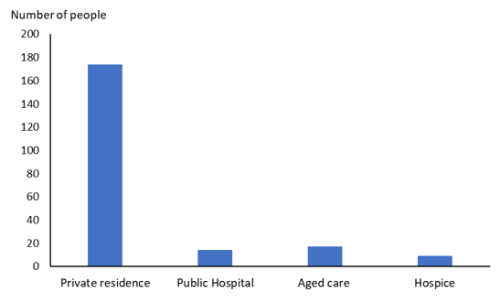

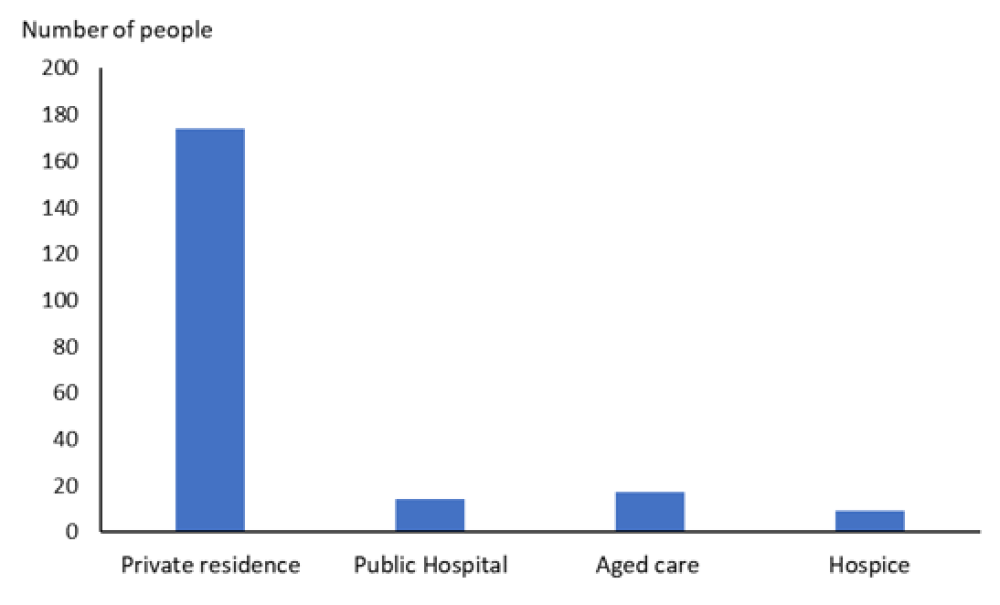
Notes:
1. “Public hospital” is used to replace “district health board facility” in the report, as there are no more District Health Boards in New Zealand from 1 July 2022.
Assisted deaths by month
Figure Four shows the number of assisted deaths by the month of the death.
Assisted deaths are required to be reported not more than 14 days after the date of death. Data for the period reported after the quarterly report cut-off date will show in the following quarterly report.
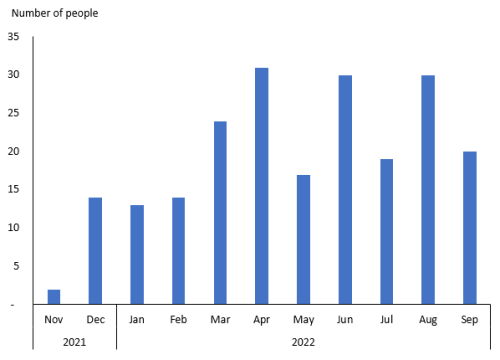
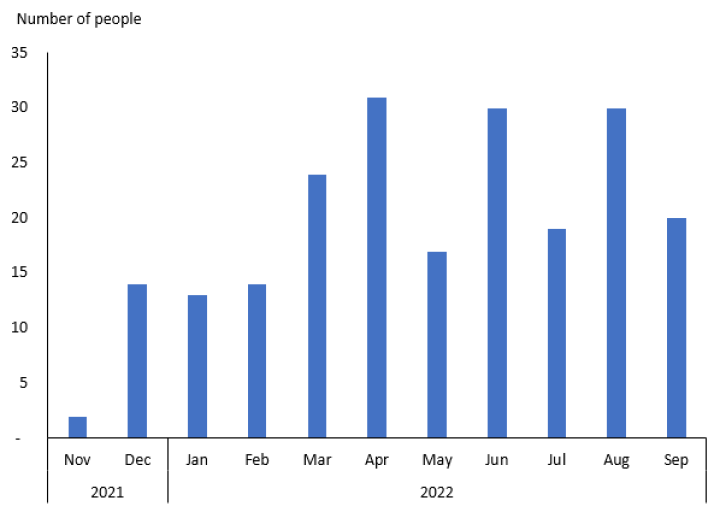

Figure Four: Assisted deaths by month 7 November 2021 – 30 September 2022
People assessed as not eligible
There are strict eligibility criteria for an assisted death. As at 30 September, 120 people had been assessed as ineligible for assisted dying.
A person may be found ineligible for more than one reason. The total number of reasons is greater than the total number of people assessed as ineligible.
Table Two: Applications assessed as ineligible by reason and assessing practitioner
|
Number of people |
% of those not eligible |
||
|---|---|---|---|
|
Reason ineligible (which criteria from the Act not met) |
Not aged 18 years or over |
0 |
0.0 |
|
Not a New Zealand Citizen or permanent resident |
5 |
2.7 |
|
|
Not experiencing unbearable suffering unable to be relieved in a tolerable manner |
44 |
23.5 | |
|
Not in an advanced state of irreversible decline in physical capability |
44 |
23.5 |
|
|
Does not suffer from a terminal illness that is likely to end their life within six months |
66 |
35.34 |
|
|
Not competent to make an informed decision about assisted dying |
28 |
15.0 |
|
|
Which practitioner |
Attending medical practitioner (AMP) |
92 |
76.7 |
|
Independent medical practitioner (IMP) |
26 | 21.7 | |
|
Registrar |
2 |
1.7 | |
| Psychiatrist | 0 | 0.0 | |
|
Total people assessed as ineligible |
120 |
|
|
Figure Five shows the number of applications assessed as ineligible by the month that the application was started.
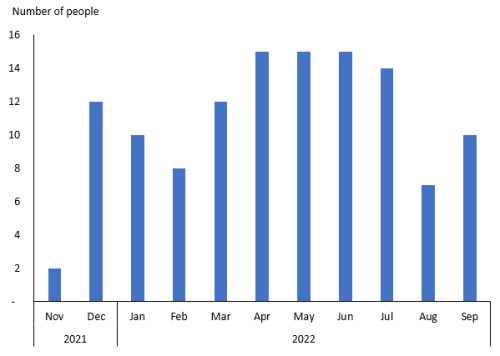
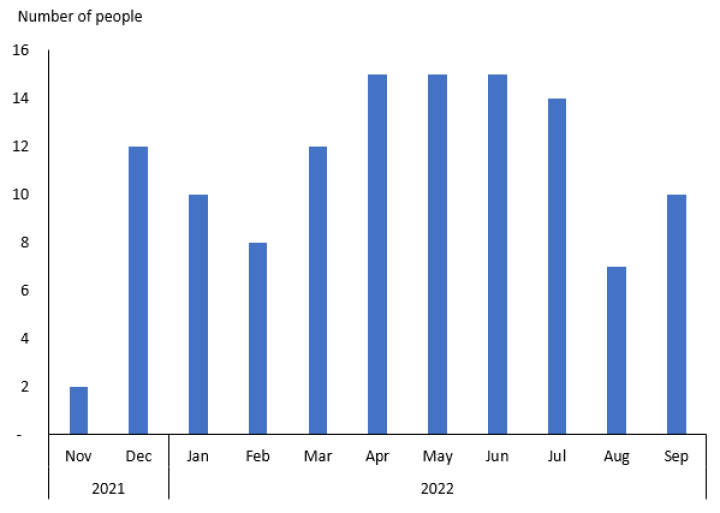

Figure Five: Applications assessed as ineligible by month 7 November 2021 – 30 September 2022
Figure Five: Applications assessed as ineligible by month 7 November 2021 – 30 September 2022
SCENZ Group practitioner lists
Table Three shows the distribution of health practitioners registered on the SCENZ Group lists (external link) by the DHB region of their usual working location and the role(s) for which they are available.
Figures below three have been suppressed for privacy reasons and are replaced with an ‘S’ in the table.
The SCENZ Group lists are dynamic and will fluctuate over time as new practitioners sign up and existing practitioners come off the lists.
Medical practitioners can be on the SCENZ list for more than one role, depending on their scope of practice (attending medical practitioner, independent medical practitioner, psychiatrist). The total number for each role will be greater than the number of unique practitioners.
The table groups practitioners by the region of their usual working location. Many practitioners are willing to travel to provide assisted dying services. Funding for travel is covered by the Ministry.
Health practitioners providing services as an attending medical practitioner (AMP) or attending nurse practitioner (ANP) do not have to be on a SCENZ Group list. For example, there are 38 general practitioners who act as the AMP for their own patients only and are not register on the SCENZ Group AMP list.
Table Three: Count of practitioners on SCENZ Group list by role and district as at 30 September
|
Region |
DHBs |
Total |
Attending |
Independent |
Psychiatrist |
Nurse |
|---|---|---|---|---|---|---|
|
Northern |
Northland |
40 |
26 |
24 |
3 |
6 |
|
Waitematā |
||||||
|
Auckland |
||||||
|
Counties Manukau |
||||||
|
Midlands |
Waikato |
23 | 15 | 17 |
S |
S |
|
Lakes |
||||||
|
Bay of Plenty |
||||||
|
Tairawhiti |
||||||
|
Taranaki |
||||||
|
Central |
Hawke's Bay |
27 |
23 | 16 |
S |
S |
|
Whanganui |
||||||
|
MidCentral |
||||||
|
Wairarapa |
||||||
|
Hutt Valley |
||||||
|
Capital & Coast |
||||||
|
Southern |
Nelson Marlborough |
42 |
28 | 24 | 5 |
S |
|
West Coast |
||||||
|
Canterbury |
||||||
|
South Canterbury |
||||||
|
Southern |
||||||
|
|
Total |
132 |
92 | 81 | 11 | 11 |
Text description
Diagram shows an overview of how the applications received up until 30 September 2022 have progressed through the assisted dying service pathway.
596 applications for assisted dying have been received.
553 first assessments were completed by attending medical practitioners.
413 second, independent, opinions were completed by independent medical practitioners.
4 psychiatrist opinions have been completed.
294 of the 596 applications had eligibility confirmed.
259 of the 596 applications ended prior to assisted death.
120 people were not eligible, 31 withdrew their application and 108 died of underlying conditions.
216 people that applied have had an assisted death.
Note
1. S = supressed data.
2. One practitioner could have multiple roles. So, the total number of unique practitioners may be different to the total number of AMPs, IMPs, Psychiatrists and Nurse Practitioners.
Disclaimer
An earlier version of this quarterly report was published with a validation error. The report has since been corrected as of 12 November 2024 to remove duplicate applications.